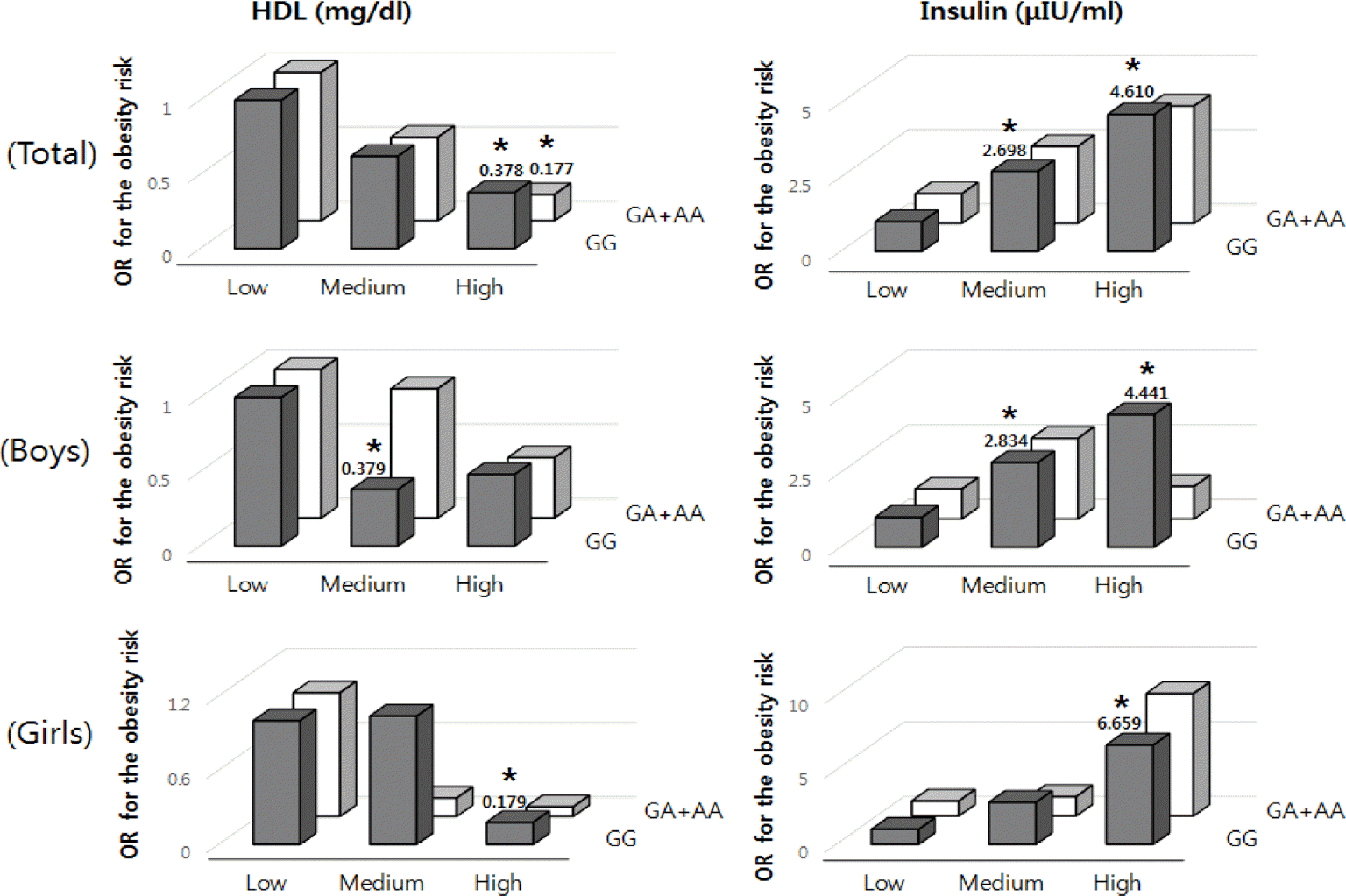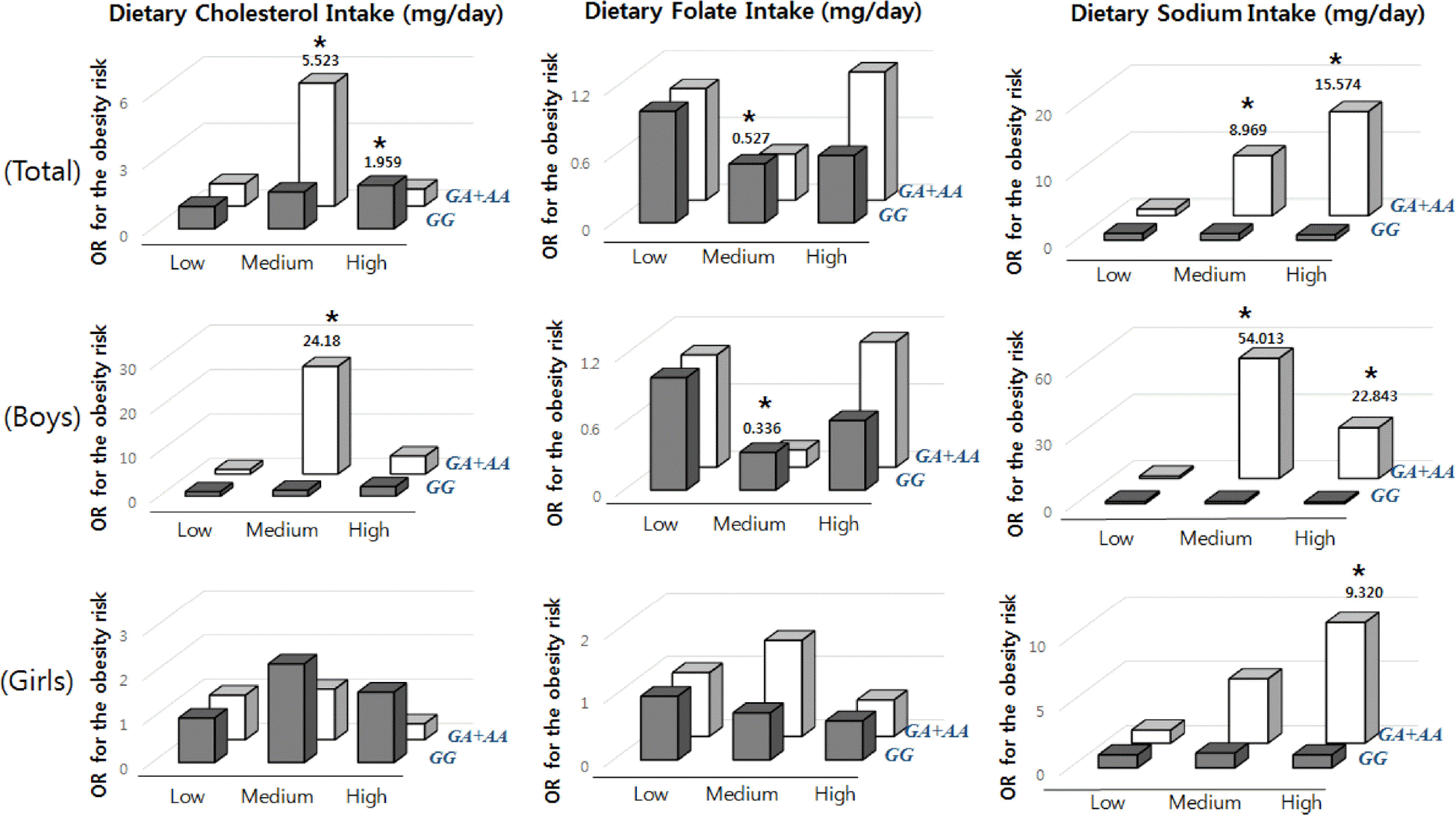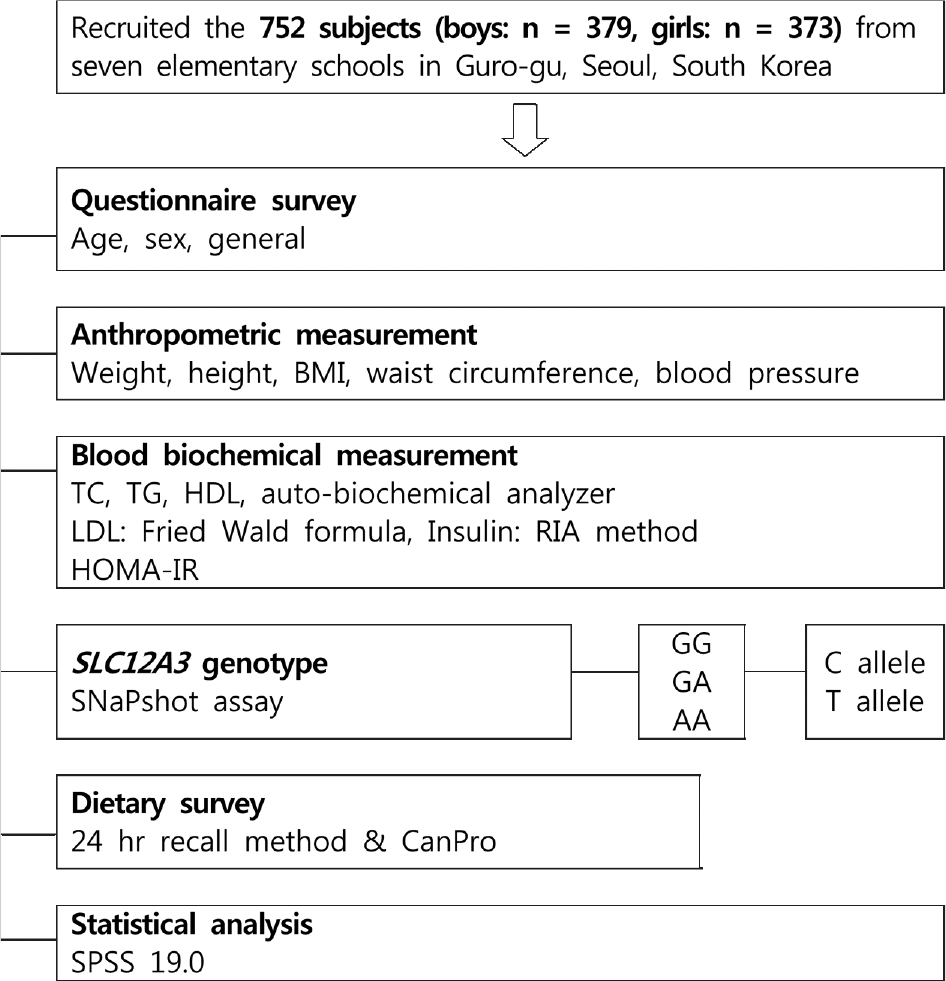1. Ministry of Health and Welfare, Korea Centers for Disease Control and Prevention. Korea Health Statistics 2012: Korea National Health and Nutrition Examination Survey (KNHANES V-3). Cheongwon: Korea Centers for Disease Control and Prevention;2013.
2. Oh K, Jang MJ, Lee NY, Moon JS, Lee CG, Yoo MH, Kim YT. Prevalence and trends in obesity among Korean children and adolescents in 1997 and 2005. Korean J Pediatr. 2008; 51(9):950–955.

3. Korean Educational Development Institute. Statistics of school health examination survey: 2011. Seoul: Korean Educational Development Institute;2011.
4. Kim JH, Kim EK. The relationship among insulin resistance, blood profiles and nutrient intake in overweight or obese children and adolescents. Korean J Community Nutr. 2012; 17(5):530–542.

5. Styne DM. Childhood and adolescent obesity. Prevalence and significance. Pediatr Clin North Am. 2001; 48(4):823–854.
6. Lee HH, Choi SK, Seo JS. Obesity index and related factors among elementary school students visiting pediatric department of general hospital. J Korean Diet Assoc. 2012; 18(2):186–199.

7. Lee SK, Kim MK. Relationship of sodium intake with obesity among Korean children and adolescents: Korea National Health and Nutrition Examination Survey. Br J Nutr. 2016; 115(5):834–841.

8. Yoon YS, Oh SW. Sodium density and obesity; the Korea National Health and Nutrition Examination Survey 2007–2010. Eur J Clin Nutr. 2013; 67(2):141–146.

9. Lee M, Kim MK, Kim SM, Park H, Park CG, Park HK. Gender-based differences on the association between salt-sensitive genes and obesity in Korean children aged between 8 and 9 years. PLoS One. 2015; 10(3):): e0120111.

10. Lee J, Lee H, Kim K, Park JH, Kim S, Oh J. A higher salt intake leads to a lower rate of adequate blood pressure control. J Korean Med Sci. 2014; 29(Suppl 2):S103–S108.

11. Intersalt: an international study of electrolyte excretion and blood pressure. Results for 24 hour urinary sodium and potassium excretion. Intersalt Cooperative Research Group. BMJ. 1988; 297(6644):319–328.
12. Libuda L, Kersting M, Alexy U. Consumption of dietary salt measured by urinary sodium excretion and its association with body weight status in healthy children and adolescents. Public Health Nutr. 2012; 15(3):433–441.

13. Hoffmann IS, Cubeddu LX. Salt and the metabolic syndrome. Nutr Metab Cardiovasc Dis. 2009; 19(2):123–128.

14. World Health Organization. Guideline. Sodium intake for adults and children. Geneva: World Health Organization;2012.
15. Lewington S, Clarke R, Qizilbash N, Peto R, Collins R. Prospective Studies Collaboration. Age-specific relevance of usual blood pressure to vascular mortality: a metaanalysis of individual data for one million adults in 61 prospective studies. Lancet. 2002; 360(9349):1903–1913.
16. He FJ, MacGregor GA. Salt reduction lowers cardiovascular risk: metaanalysis of outcome trials. Lancet. 2011; 378(9789):380–382.

17. Brater DC. Pharmacology of diuretics. Am J Med Sci. 2000; 319(1):38–50.

18. Fava C, Montagnana M, Rosberg L, Burri P, Almgren P, Jönsson A, Wanby P, Lippi G, Minuz P, Hulthèn LU, Aurell M, Melander O. Subjects heterozygous for genetic loss of function of the thiazide-sensitive cotransporter have reduced blood pressure. Hum Mol Genet. 2008; 17(3):413–418.

19. Melander O, Orho-Melander M, Bengtsson K, Lindblad U, Râs-tam L, Groop L, Hulthén UL. Genetic variants of thiazide-sensitive NaCl-cotransporter in Gitelman's syndrome and primary hypertension. Hypertension. 2000; 36(3):389–394.

20. Knoers NV, Levtchenko EN. Gitelman syndrome. Orphanet J Rare Dis. 2008; 3(1):22.

21. Hoorn EJ, Ellison DH. WNK kinases and the kidney. Exp Cell Res. 2012; 318(9):10201026.

22. Mercier-Zuber A, O'Shaughnessy KM. Role of SPAK and OSR1 signalling in the regulation of NaCl cotransporters. Curr Opin Nephrol Hypertens. 2011; 20(5):534–540.

23. McCormick JA, Mutig K, Nelson JH, Saritas T, Hoorn EJ, Yang CL, Rogers S, Curry J, Delpire E, Bachmann S, Ellison DH. A SPAK isoform switch modulates renal salt transport and blood pressure. Cell Metab. 2011; 14(3):352–364.

24. Castañeda-Bueno M, Gamba G. Mechanisms of sodium-chloride cotransporter modulation by angiotensin II. Curr Opin Nephrol Hypertens. 2012; 21(5):516–522.

25. Arroyo JP, Lagnaz D, Ronzaud C, Vázquez N, Ko BS, Moddes L, Ruffieux-Daidié D, Hausel P, Koesters R, Yang B, Stokes JB, Hoover RS, Gamba G, Staub O. Nedd4–2 modulates renal Na+-Cl-cotransporter via the aldosterone-SGK1-Nedd4–2 pathway. J Am Soc Nephrol. 2011; 22(9):1707–1719.

26. Moon JS, Lee SY, Nam CM, Choi JM, Choe BK, Seo JW, Oh K, Jang MJ, Hwang SS, Yoo MH, Kim YT, Lee CG. 2007 Korean National Growth Charts: review of developmental process and an outlook. Korean J Pediatr. 2008; 51(1):1–25.

27. Friedewald WT, Levy RI, Fredrickson DS. Estimation of the concentration of low-density lipoprotein cholesterol in plasma, without use of the preparative ultracentrifuge. Clin Chem. 1972; 18(6):499–502.

28. Matthews DR, Hosker JP, Rudenski AS, Naylor BA, Treacher DF, Turner RC. Homeostasis model assessment: insulin resistance and beta-cell function from fasting plasma glucose and insulin concentrations in man. Diabetologia. 1985; 28(7):412–419.
29. Willett WC, Howe GR, Kushi LH. Adjustment for total energy intake in epidemiologic studies. Am J Clin Nutr. 1997; 65(4 Suppl):1220S–1228S.

30. Magnussen CG, Thomson R, Cleland VJ, Ukoumunne OC, Dwyer T, Venn A. Factors affecting the stability of blood lipid and lipoprotein levels from youth to adulthood: evidence from the Childhood Determinants of Adult Health Study. Arch Pediatr Adolesc Med. 2011; 165(1):68–76.

31. Cesa CC, Sbruzzi G, Ribeiro RA, Barbiero SM, de Oliveira Petkowicz R, Eibel B, Machado NB, Marques R, Tortato G, dos Santos TJ, Leiria C, Schaan BD, Pellanda LC. Physical activity and cardiovascular risk factors in children: metaanalysis of randomized clinical trials. Prev Med. 2014; 69:54–62.

32. Marcovecchio ML, Mohn A, Chiarelli F. Obesity and insulin resistance in children. J Pediatr Gastroenterol Nutr. 2010; 51(Suppl 3):S149–S150.

33. Bahrami E, Mirmoghtadaee P, Ardalan G, Zarkesh-Esfahani H, Tajaddini MH, Haghjooy-Javanmard S, Najafi H, Kelishadi R. Insulin and leptin levels in overweight and normal-weight Iranian adolescents: the CASPIAN-III study. J Res Med Sci. 2014; 19(5):387–390.
34. Del Mar Bibiloni M, Maffeis C, Llompart I, Pons A, Tur JA. Dietary factors associated with subclinical inflammation among girls. Eur J Clin Nutr. 2013; 67(12):1264–1270.

35. García OP, Ronquillo D, Caamaño Mdel C, Camacho M, Long KZ, Rosado JL. Zinc, vitamin A, and vitamin C status are associated with leptin concentrations and obesity in Mexican women: results from a cross-sectional study. Nutr Metab (Lond). 2012; 9(1):59.

36. Wang YL, Qi Y, Bai JN, Qi ZM, Li JR, Zhao HY, Wang YF, Lu CZ, Xiao Y, Jia N, Wang B, Niu WQ. Tag polymorphisms of solute carrier family 12 member 3 gene modify the risk of hypertension in northeastern Han Chinese. J Hum Hypertens. 2014; 28(8):504–509.

37. Gopinath B, Flood VM, Burlutsky G, Louie JC, Baur LA, Mitchell P. Dairy food consumption, blood pressure and retinal microcirculation in adolescents. Nutr Metab Cardiovasc Dis. 2014; 24(11):1221–1227.

38. Yuan WL, Kakinami L, Gray-Donald K, Czernichow S, Lambert M, Paradis G. Influence of dairy product consumption on children's blood pressure: results from the QUALITY cohort. J Acad Nutr Diet. 2013; 113(7):936–941.

39. Yang SJ, Kim S, Park H, Kim SM, Choi KM, Lim Y, Lee M. Sex-dependent association between angiotensin-converting enzyme insertion/deletion polymorphism and obesity in relation to sodium intake in children. Nutrition. 2013; 29(3):525–530.

40. Enquobahrie DA, Feldman HA, Hoelscher DH, Steffen LM, Webber LS, Zive MM, Rimm EB, Stampfer MJ, Osganian SK. Serum homocysteine and folate concentrations among a US cohort of adolescents before and after folic acid fortification. Public Health Nutr. 2012; 15(10):1818–1826.

41. Hoey L, McNulty H, Askin N, Dunne A, Ward M, Pentieva K, Strain J, Molloy AM, Flynn CA, Scott JM. Effect of a voluntary food fortification policy on folate, related B vitamin status, and homocysteine in healthy adults. Am J Clin Nutr. 2007; 86(5):1405–1413.

42. Gallistl S, Sudi K, Mangge H, Erwa W, Borkenstein M. Insulin is an independent correlate of plasma homocysteine levels in obese children and adolescents. Diabetes Care. 2000; 23(9):1348–1352.

43. Ullegaddi R, Powers HJ, Gariballa SE. B-group vitamin supplementation mitigates oxidative damage after acute ischaemic stroke. Clin Sci (Lond). 2004; 107(5):477–484.

44. Folsom AR, Desvarieux M, Nieto FJ, Boland LL, Ballantyne CM, Chambless LE. B vitamin status and inflammatory markers. Atherosclerosis. 2003; 169(1):169–174.

45. Voutilainen S, Virtanen JK, Rissanen TH, Alfthan G, Laukkanen J, Nyyssönen K, Mursu J, Valkonen VP, Tuomainen TP, Kaplan GA, Salonen JT. Serum folate and homocysteine and the incidence of acute coronary events: the Kuopio Ischaemic Heart Disease Risk Factor Study. Am J Clin Nutr. 2004; 80(2):317–323.







 PDF
PDF ePub
ePub Citation
Citation Print
Print



 XML Download
XML Download